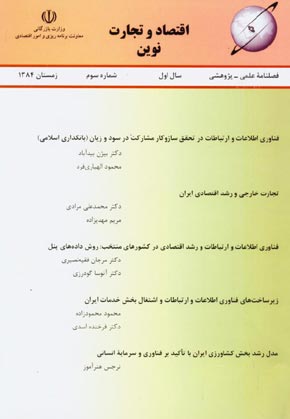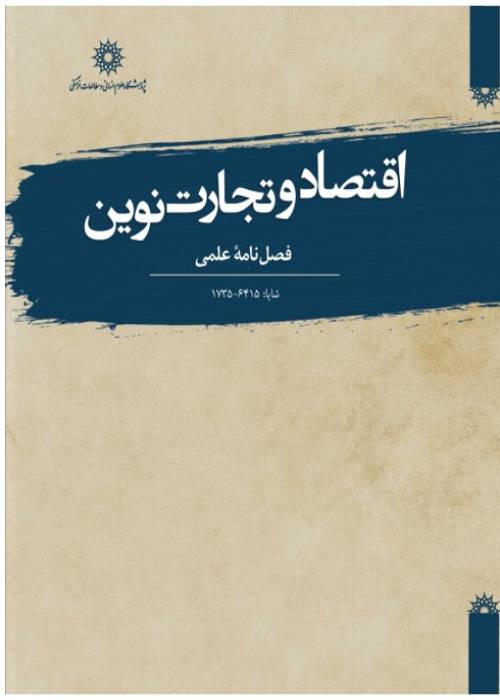فهرست مطالب

نشریه اقتصاد و تجارت نوین
پیاپی 3 (زمستان 1384)
- 146 صفحه، بهای روی جلد: 10,000ريال
- تاریخ انتشار: 1384/11/25
- تعداد عناوین: 7
- مقالات
-
صفحه 1این مقاله نحوه تحقق نظام بانکداری غیر ربوی که تمامی ادیان الهی بر آن تاکید دارند را با استفاده از سیستم های فناوری اطلاعات به طور دقیق و به دور از هر گونه شبهه تبیین می نماید. با سیستم های یکپارچه در جامعه الکترونیک تمامی عوامل تاثیرگذار در بانکداری را می توان به مثابه حلقه های یک زنجیر به هم پیوند داد و بازدهی واقعی حاصل از سرمایه گذاری منابع پولی سپرده گذاران را از طریق کانال های امن دیجیتالی در بخش حقیقی اقتصاد، توزیع کرد. کانال های توزیع خدمات در بانکداری غیر ربوی نوین مانند بانکداری نوین از طریق شعب و سایر کانال های دیجیتالی قابل ارائه است...
کلیدواژگان: مشارکت در سود و زیان، فناوری اطلاعات و ارتباطات، بانکداری غیر ربوی، ربا، تامین مالی -
صفحه 38بررسی نظریات رشد عمدتا موید رابطه مثبت بین تجارت خارجی و رشد اقتصادی است. در چارچوب نظریات رشد درونزا، تجارت خارجی از طریق مبادله کالاها و خدمات، به ویژه کالاهای سرمایه ای و واسطه ای منجر به انتقال دانش و فناوری می شود، تجارت خارجی با بهبود تخصیص منابع، دسترسی به تکنولوژی ها (فناوری) و کالاهای واسطه بهتر، استفاده از صرفه های ناشی از مقیاس تولید، افزایش رقابت داخلی و ایجاد محیط مناسب ابداعات بر رشد اقتصادی تاثیر می گذارد. با وجود این، شواهد تجربی تفسیر متفاوتی از تاثیر تجارت خارجی بر رشد اقتصاد ارائه می کند...
کلیدواژگان: تابع تولید، رشد اقتصادی، تجارت خارجی، انتقال فناوری، سرمایه انسانی، تحلیل های سری زمانی، ایران -
صفحه 73اثر به کارگیری فناوری اطلاعات و ارتباطات بر رشد اقتصادی، یکی از موضوعات جدالی در دهه های اخیر به شمار می رود. این مطالعه با توجه به ادبیات موجود (مبانی نظری، روش شناسی، مدل سازی و شیوه های برآورد) سعی دارد به طراحی مدلی برای تشریح اثر فناوری اطلاعات و ارتباطات بر رشد اقتصادی نمونه ای متشکل از 37 کشور در حال توسعه و توسعه یافته برای دروه 1995 - 2003 با به کارگیری روش داده های پنل بپردازد. سه مدل رشد به تفکیک تمامی کشورهای نمونه، کشورهای در حال توسعه و کشورهای توسعه یافته تخمین زده می شود...
کلیدواژگان: فناوری اطلاعات و ارتباطات، رشد اقتصادی، داده های پنل، کشورهای پیشرفته و در حال توسعه -
صفحه 95فناوری اطلاعات و ارتباطات به عنوان یک نهاده، نقشی مهم در تولید و اشتغال دارد. از یک سو ICT ممکن است با جانشین شدن به جای نیروی انسانی باعث کاهش اشتغال شود و از سوی دیگر با گسترش مقیاس تولید و ایجاد پتانسیل ها (توانایی ها) و فرصت های جدید، اشتغال را افزایش دهد. به همین دلیل، به لحاظ نظری ار خالص فناوری اطلاعات و ارتباطات بر اشتغال روشن نیست و لازم است بر اساس شرایط اقتصادی هر کشور، اثر خالص آن آزمون و ارزیابی شود. این مقاله به بررسی تاثیر زیرساخت های فناوری اطلاعات و ارتباطات بر اشتغال بخش خدمات در ایران اختصاص دارد...
کلیدواژگان: زیرساخت های فناوری اطلاعات و ارتباطات، نوآوری فرآیندی و تولیدی، تقاضای اشتغال، تحلیل های سری زمانی، ایران -
صفحه 119هدف این مقاله شناسایی متغیرهای موثر و برآورد کمی تاثیر آنها بر رشد ارزش افزوده کشاورزی ایران است. در این مورد از نظریه های مطرح شده الگوهای رشد جدید که با ساختار بخش کشاورزی ایران تناسب دارند، استفاده شده است. مهم ترین این عوامل سرمایه انسانی و فناوری است. اهمیت کیفیت نیروی انسانی در تاثیر فراوان آن بر رشد اقتصادی است. ایجاد نوآوری های تکنولوژیکی (فناورانه) در عرصه تولید که خود نتیجه تحقق و توسعه یا انباشت دانش است، موجب بهبود روش به کارگیری عوامل تولید می گردد...
کلیدواژگان: تابع تولید، مدل رشد بخش کشاورزی، فناوری تولید، سرمایه انسانی، ایران -
راهنمای نویسندگانصفحه 138
-
چکیده انگلیسیصفحه 142
-
Page 1This paper introduces a new ICT master solution to improve the non-usury banking performance. It is proposed that with some ICT solutions, it is possible to fulfill worldly requirement by use of ICT systems without any incredulity. Since depositors are shareholders of Non-Usury Bank Corporation (NUBankCo), integrated information systems can provide suitable infrastructure for transactions recording and management done by all participant's chains; and the end of process the yields of investment capital of depositors that invest in real economy can be distributed by safe delivery channels such as branches, ATM, WEB, and Meaningful WEB IT (i. e. BPR, ERP, CRM, SCM, MES, MEX, HRM, and WFM) uses single and integrated data warehouses accompanying with standardization in all processes. It prepares PLS mechanism as main difference between conventional and non-usury banking and also simplifies risk management and decline operational risk in comparison with conventional non-usury banking. This paper aims to find a solution to the question: is it possible to connect depositors, bank, and investors in an integrated ICT system to bring out PLS mechanism? Accordingly, a new kind of bank named by "Non-Usury Bank Corporation (NubankCo)" is used to fulfill PLS criterion. Foundation of real non-usury banking can be based on an integrated ICT system that links depositors, NUBankCo, business partners, investors, stock exchange agencies, social security organizations, and certificate authorities (CA). Therefore, all related sectors may access the working flow of capital, ICT processes, and investment returns and this causes stability in financial markets and achieve social justice establishment.Keywords: ICT, PLS, Islamic Banking, Finance, Usury
-
Page 38Trade promotes growth through increased specialization, efficient resource allocation, diffusion of international knowledge, and heightened domestic competition. Recent advances in the theory of endogenous technological progress have led to renewed interest in the relation between trade, technological change, human capital and economic growth. In theory, trade yields gains for growth, via at least three main channels. The first channel of growth through trade derives from the opportunity that trade specialization offers to exploit comparative advantage. A second channel of growth from trade is via its impact on the flow of ideas, knowledge and technologies, and finally, trade itself is linked with the discovery of new ways of doing things. Despite these seemingly positive growth aspects of international trade, the empirical evidence on the effects of trade on growth appears to be mixed. The ambiguous results are related to conceptual and empirical shortcomings. This paper conducts an empirical investigation of the role of trade in determining the rate of economic growth in Iran using the annual data from 1959 to 2003. The results show that the rate of real per capita physical capital stock and the rate of human capital stock have by far the greatest effects on real per capita GDP growth. The variables have coefficients above 0.4 and are statistically significant in the per capita GDP growth regression. The third strongest impact comes from the rate of inflation which has a negative effect on the real per capita GDP growth and finally a positive relationship between international trade indicators and economic growth is found and it is concluded that trade has a positive effect on growth but this effects relatively is not strong.Keywords: Production Function, Economic Growth, International Trade, Technology Diffusion, Human Capital, Iran
-
Page 73Growth performances vary across countries. The determinants of growth are not unique for all countries that contribute to such variations. One of the challenging issues during recent decades is to investigate the effect of information and communication technology (ICT) on economic growth. ICT is essential to growth, necessary to develop a country’s productive capacity in all sectors of the economy, and links a country with the global economy and ensures competitiveness. It is seminal to invention, innovation, and wealth creation. The objective of this paper is to analyze the effect of ICT on the economic growth in developed and developing economies using a panel data of 37 countries over the period 1995-2003. Three separate models are estimated for the whole sample as well as the two different samples of the developed and developing countries. The findings show that the coefficient of the real per capita ICT expenditures for developed and developing countries are 0.018 and 0.013, respectively, confirming the positive and significant effects of ICT on the economic growth in the sample countries.Keywords: ICT, Economic Growth, Panel Data, Developed, Developing Countries
-
Page 95An increasing body of research links information and communication technology (ICT) investments to the employment. In one hand, ICT can be substituted for labor force and decreases employment. On the other hand, ICT can promote the production scale and create the new opportunities and increase employment. Therefore, in theory the net impact of ICT on employment isn’t clear. The aim of this paper is to investigate the effect of ICT infrastructures on employment of service sector in Iran using annul data over the period 1971-2003. An ARDL technique is used to estimate the short run and long run relationships. Empirical findings show that the employment elasticity with respect to the capital stock of ICT infrastructures is 0.13 and 1.01 in the short run and long run, respectively. This indicates the positive and significant impact of ICT infrastructures on the employment in Iran. Employment elasticity with respect to the value added of service sector is 0.27 in the long run and finally, employment elasticity with respect to the ratio of high skill labor force over the total labor force is slightly lower in absolute value in the short run (-0.02), but it increases to -0.16 in the long run.Keywords: ICT, Labor Demand, Process Innovation, Product Innovation, Service Sector: Iran
-
Page 119Recent advances in the theory of endogenous technological progress have led to renewed interest in the relation between technology diffusion, human capital and economic growth. Therefore, to assess the effects of human capital and technology on growth, an econometric model is specified for the agricultural sector of Iran. This study has adopted a general version of the Cobb-Douglas production function, which in addition to the traditional inputs also includes human capital and technology. ARDL technique is employed to estimate the specified agricultural model using the data over the period 1971-2003. First, the production function is estimated and then the results are used to estimate the agricultural growth equation using error correction model framework. The results of model indicate that human capital and technology have positive and significant effects on the agricultural growth rate of Iran.Keywords: Production Function, Agricultural Growth, Technology, Human Capital, Iran


